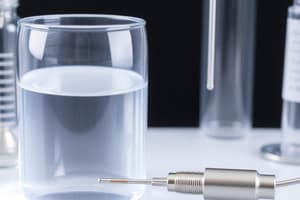Podcast
Questions and Answers
The working electrode is often a drop suspended from the end of a ______ tube.
The working electrode is often a drop suspended from the end of a ______ tube.
capillary
The DME stands for ______ mercury electrode.
The DME stands for ______ mercury electrode.
dropping
The optimum interval between drops for most analysis is between ______ to 5 seconds.
The optimum interval between drops for most analysis is between ______ to 5 seconds.
2
The vast majority of reactions studied with the mercury electrode are ______.
The vast majority of reactions studied with the mercury electrode are ______.
A mercury electrode is not very useful for performing ______, because Hg is too easily oxidized.
A mercury electrode is not very useful for performing ______, because Hg is too easily oxidized.
The polarographic apparatus consists of a polarizable electrode (DME) and a ______ electrode.
The polarographic apparatus consists of a polarizable electrode (DME) and a ______ electrode.
Supporting electrolytes like potassium chloride are added to the sample solution to eliminate ______ current.
Supporting electrolytes like potassium chloride are added to the sample solution to eliminate ______ current.
The height of the mercury reservoir is adjusted so that drop time of about ______ to 7 seconds is set.
The height of the mercury reservoir is adjusted so that drop time of about ______ to 7 seconds is set.
The polarographic technique is used for the qualitative or quantitative analysis of electroreducible or oxidisable ______.
The polarographic technique is used for the qualitative or quantitative analysis of electroreducible or oxidisable ______.
The principle of polarography involves applying a gradually increasing negative ______ between two electrodes.
The principle of polarography involves applying a gradually increasing negative ______ between two electrodes.
The dropping mercury electrode is an example of a ______ electrode used in polarography.
The dropping mercury electrode is an example of a ______ electrode used in polarography.
The point of inflection in the current-voltage curve is known as the ______-wave potential.
The point of inflection in the current-voltage curve is known as the ______-wave potential.
The diffusion current measured in polarography is proportional to the concentration of the specific ______.
The diffusion current measured in polarography is proportional to the concentration of the specific ______.
The linear relationship between the diffusion current and the concentration of electroactive species is represented by the ______ equation.
The linear relationship between the diffusion current and the concentration of electroactive species is represented by the ______ equation.
In polarography, even low concentrations of samples can be detected, ranging from ______ M to ______ M.
In polarography, even low concentrations of samples can be detected, ranging from ______ M to ______ M.
Mercury is used as a working ______ in polarography due to its liquid state.
Mercury is used as a working ______ in polarography due to its liquid state.
An increase of current above the limiting value in the form of a maximum is known as polarographic ______.
An increase of current above the limiting value in the form of a maximum is known as polarographic ______.
Maximum suppressors, such as gelatin, help eliminate polarographic ______.
Maximum suppressors, such as gelatin, help eliminate polarographic ______.
The ______ current is the sum of the relatively larger condenser current and a very small Faradic current.
The ______ current is the sum of the relatively larger condenser current and a very small Faradic current.
The migration current is due to migration of cations from the bulk of the solution towards the ______.
The migration current is due to migration of cations from the bulk of the solution towards the ______.
Diffusion current is caused by the actual diffusion of electroreducible ions from the bulk of the sample to the surface of the ______ droplet.
Diffusion current is caused by the actual diffusion of electroreducible ions from the bulk of the sample to the surface of the ______ droplet.
The diffusion current varies inversely with the ______ of the medium.
The diffusion current varies inversely with the ______ of the medium.
The concentration of the electroreducible ions has a ______ relationship with diffusion current.
The concentration of the electroreducible ions has a ______ relationship with diffusion current.
The ______ current reaches a steady value known as the limiting current beyond a certain potential.
The ______ current reaches a steady value known as the limiting current beyond a certain potential.
Flashcards
Polarography
Polarography
An electrochemical technique that measures current flow between two electrodes in a solution as the applied voltage increases gradually. This allows for the determination of the concentration and nature of a solute.
Dropping Mercury Electrode (DME)
Dropping Mercury Electrode (DME)
A polarizable electrode used in polarography where mercury drops continuously from a capillary tube, providing a fresh surface for each measurement.
Non-Polarizable Electrode
Non-Polarizable Electrode
A non-polarizable electrode used in polarography that maintains a stable potential even with varying current. It is often a saturated calomel electrode.
Half-wave Potential
Half-wave Potential
Signup and view all the flashcards
Diffusion Current
Diffusion Current
Signup and view all the flashcards
Ilkovic Equation
Ilkovic Equation
Signup and view all the flashcards
Electroactive Species
Electroactive Species
Signup and view all the flashcards
Advantages of Polarography
Advantages of Polarography
Signup and view all the flashcards
Static Mercury Drop Electrode (DSME)
Static Mercury Drop Electrode (DSME)
Signup and view all the flashcards
Hanging Mercury Drop Electrode (HMDE)
Hanging Mercury Drop Electrode (HMDE)
Signup and view all the flashcards
Overpotential
Overpotential
Signup and view all the flashcards
Working Electrode
Working Electrode
Signup and view all the flashcards
Reference Electrode
Reference Electrode
Signup and view all the flashcards
Migration Current
Migration Current
Signup and view all the flashcards
Supporting Electrolyte
Supporting Electrolyte
Signup and view all the flashcards
Polarographic Maxima
Polarographic Maxima
Signup and view all the flashcards
What issue does polarographic maxima cause?
What issue does polarographic maxima cause?
Signup and view all the flashcards
What are maximum suppressors?
What are maximum suppressors?
Signup and view all the flashcards
What is condenser current?
What is condenser current?
Signup and view all the flashcards
What is migration current?
What is migration current?
Signup and view all the flashcards
What is diffusion current?
What is diffusion current?
Signup and view all the flashcards
What is the limiting current?
What is the limiting current?
Signup and view all the flashcards
What factors affect diffusion current?
What factors affect diffusion current?
Signup and view all the flashcards
Study Notes
Introduction to Polarography
- Polarographic technique analyzes electroreducible or oxidizable elements/groups.
- It's an electromechanical technique, measuring current between electrodes in a solution while increasing voltage.
- This helps determine solute concentration and nature.
- Invented by Jaroslav Heyrovský.
Principle of Polarography
- Polarography involves applying a gradually increasing negative potential between a polarizable and non-polarizable electrode.
- Polarizable electrode: Dropping mercury electrode
- Non-polarizable electrode: Saturated calomel electrode
- The current is measured.
- The resulting current-voltage curve (sigmoid shape) allows qualitative and quantitative analysis.
- The technique is called polarography.
- The instrument used is a polarograph, and the curve recorded is a polarogram.
Polarographic Measurements
- Measurements are governed by the Ilkovic Equation.
- Ilkovic Equation: The relationship between diffusion current (id) and the concentration of electroactive species.
- Formula for Ilkovic Equation: id = 607 nCD1/2 m2/3 t1/6
- id = diffusion current in microamperes
- n = number of electrons required per molecule
- C = concentration
- D = diffusion coefficient
- m = mass of mercury flow
- t = drop time
Advantages of Polarography
- Analysis of organic and inorganic samples.
- Detection of even low concentrations (10-3 M to 10-4 M).
- Rapid analysis.
- Enables easy qualitative and quantitative analysis.
- Mixture analysis without separation.
Mercury Electrodes
- Mercury is a liquid electrode, often a drop suspended from a capillary tube.
- Types:
- Hanging mercury drop electrode (HMDE)
- Dropping mercury electrode (DME)
- Static mercury drop electrode (SMDE)
- DME is commonly used; Mercury drops form at the end of a capillary tube due to gravity.
Why Dropping Mercury Electrode?
- Reproducible current-potential data due to continuous fresh surface exposure.
- Potential depends less on surface conditions of other electrodes (like Pt).
- Solvent reduction does not interfere with analyte reduction at high overpotential.
Problems with Mercury Electrode
- Mercury is easily oxidized, thus unsuitable for oxidations.
- Use is limited to potentials of less than 0.4 V (vs SCE), above which mercury dissolves.
- Hydrogen liberation occurs below -1.8V
- Capillary maintenance is challenging due to clogging.
Method of Analysis
- Polarographic apparatus comprises a polarizable electrode (DME) and a reference electrode (SCE).
- A potential range of 0 to -3 V can be applied between electrodes.
- An analysis cell, typically made of glass, is used to hold the sample.
- The height of the mercury reservoir is adjusted to set a drop time of around 2-7 seconds.
Supporting Electrolytes & Maximum Suppressors in Polarography
- Supporting electrolytes (like KCl) remove migration current
- Oxygen in the sample is eliminated with nitrogen or alkaline pyrogallol.
- Maximum suppressors are added (like gelatin, dyes, surfactants).
- Initial and final potentials are set in the instrument.
- Current-voltage curves (polarograms) are recorded.
- The polarogram helps determine half-wave potential and diffusion current and performs qualitative and quantitative analysis.
Polarographic Maxima
- An increase in current above expected values is a polarographic maximum, often noticed on polarographic waves.
- Maxima often originate from catalytic discharge of ions, or increased depolarizer transport, causing a streaming action
- Maxima lead to errors in determining half-wave potential and diffusion current.
Elimination of Polarographic Maxima
- Maximum suppressors (gelatin, dyes, surfactants), which increase viscosity, help eliminate maxima.
Different Types of Current in Polarography
- Residual current: The sum of condenser current and small Faradic current (due to impurities).
- Migration current: Caused by cation migration towards the cathode, irrespective of concentration gradient.
- Diffusion current: Resulting from electroreducible ions diffusing to the mercury drop surface due to the concentration gradient.
- Limiting current: A steady current value beyond a certain potential; diffusion rate equals reduction rate.
Factors Affecting Diffusion Current
- Concentration: Directly proportional to diffusion current.
- Temperature: Directly proportional to diffusion current.
- Viscosity: Diffusion coefficient depends on viscosity, thus affecting diffusion current.
- Capillary characteristics: Capillary bore size, drop time, and mercury pressure impact diffusion current.
- Presence of Maximum Suppressors: Maximum suppressors influence diffusion current.
Pharmaceutical Applications
- Used for analysis of dissolved oxygen, peroxides, trace metals, metal-containing drugs, antiseptics, insecticides, vitamins, hormones, antibiotics, alkaloids, blood serum, and cancer diagnostics.
Advantages of Polarography
- Small sample volume required.
- Analysis of turbid and colored solutions is possible.
- Applicable to substances not electrochemically active (indirect analysis).
- No prior separation of components required.
- High sensitivity for trace elements and toxic impurities.
- High speed analysis is beneficial for quality control (QC).
Studying That Suits You
Use AI to generate personalized quizzes and flashcards to suit your learning preferences.




